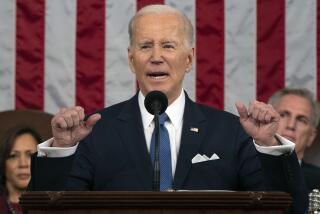Struggling to fill in the blanks on Mitt Romney’s tax plan
GOP presidential candidate Mitt Romney could not have been surprised when his tax plan came under attack by President Obama at Tuesday night’s debate. After all, both Obama and Vice President Biden had focused on the plan before, contending that there was no way it could work as Romney claimed.
So why, then, did Romney stick to the same vague response? Not only that -- he punted on a telling follow-up question about how he’d respond if he could get some but not all elements of his plan through Congress.
The exchange began with audience member Mary Follano asking Romney whether his tax plan would eliminate the tax deductions and credits for mortgage interest, charitable donations, dependent children and college tuition. Rather than giving a yes-or-no answer, he said one approach might be to limit the amount of deductions and credits a taxpayer can claim, but let him or her decide which ones to use. He also insisted that he wouldn’t reduce the share of the tax burden paid by the top 5% of U.S. households, adding, “I’m not looking to cut taxes for wealthy people. I am looking to cut taxes for middle-income people.”
DEBATE LOG: Second Presidential Debate
Obama responded by contending that Romney’s fiscal plan would result in $6 trillion in lost revenue and lead to $2 trillion in additional defense spending. “Now, what he says is he’s going to make sure that this doesn’t add to the deficit and he’s going to cut middle-class taxes. But when he’s asked, how are you going to do it, which deductions, which loopholes are you going to close? He can’t tell you....
“Now, Governor Romney was a very successful investor. If somebody came to you, governor, with a plan that said, here, I want to spend $7 or $8 trillion, and then we’re going to pay for it, but we can’t tell you until maybe after the election how we’re going to do it, you wouldn’t take such a sketchy deal, and neither should you, the American people, because the math doesn’t add up.”
Romney has tried to fend off such critiques in the past by saying he was simply laying down principles for the plan, and would leave the details to be worked out by Congress. And if that sounds like a dodge, it’s also a pretty good description for how Obama approached two of his biggest legislative accomplishments: the 2010 healthcare reform law and the 2009 economic stimulus act. In both of those cases, Obama gave lawmakers an outline and let them work out the specifics.
PHOTOS: The presidential debate
The real problem for Romney is that he hasn’t offered an actual example of how all of the goals he’s laid out could be met. He’s cited a handful of studies and opinion pieces that purport to back his plan, but none of them actually demonstrate a way to cut individual tax rates 20% below the levels set during the Bush administration, keep higher-income households paying the same share of the taxes, cut corporate rates 10%, eliminate the Alternative Minimum Tax and the estate tax, and expand the tax break for investment income (to eliminate those taxes for middle- and lower-income families) without increasing the deficit.
The one that comes closest -- a study by the conservative Tax Foundation -- assumes that robust economic growth would help compensate for the rate cuts. But the congressional economists who calculate the cost of tax bills don’t factor in any increase in the GDP, so the Tax Foundation’s study doesn’t prove that Romney’s numbers would work from Congress’ point of view.
After Obama’s “sketchy deal” jibe, moderator Candy Crowley of CNN asked the natural follow-up. “If somehow when you get in there, there isn’t enough tax revenue coming in, if somehow the numbers don’t add up,” Crowley asked Romney, would he be willing to settle for less than a 20% cut?
Romney’s answer: “Well of course they add up.” And people should trust him on that, he said, because he’s been a businessman and a former governor who balanced budgets.
Granted, politicians hate hypotheticals, but that’s still a lousy answer. Crowley was posing a reasonableness test: if you can’t get everything you want from a Congress that’s been notoriously uncooperative with the White House, how will you react? And Romney’s answer was, in effect, “What do you mean I can’t get everything I want?”
A better answer would have been to lay out some priorities. Is having a deep cut in rates more important than having a deficit-neutral plan? Are the corporate cuts more important than the individual ones? Is tax simplification more important than keeping the tax code progressive? Although each of these trade-offs has a political cost, the real issue is the economics. If the goal is to grow the economy, which elements of the plan matter the most?
Crowley’s question gave Romney another opportunity to explain how the various pieces of his plan work, and in doing so advance his views on how government policies affect the economy. At the very least, it was a chance for Romney to add some clarity to a plan that’s being demonized -- in some ways unfairly, but in some ways not -- for its lack of detail. Too bad he didn’t take advantage of it.
ALSO:
Republicans for ‘Sesame Street’
McManus: Who wins a tied debate?
Presidential debate Round 2: Fantastic theater but not decisive politics
Follow Jon Healey on Twitter @jcahealey
More to Read
A cure for the common opinion
Get thought-provoking perspectives with our weekly newsletter.
You may occasionally receive promotional content from the Los Angeles Times.











